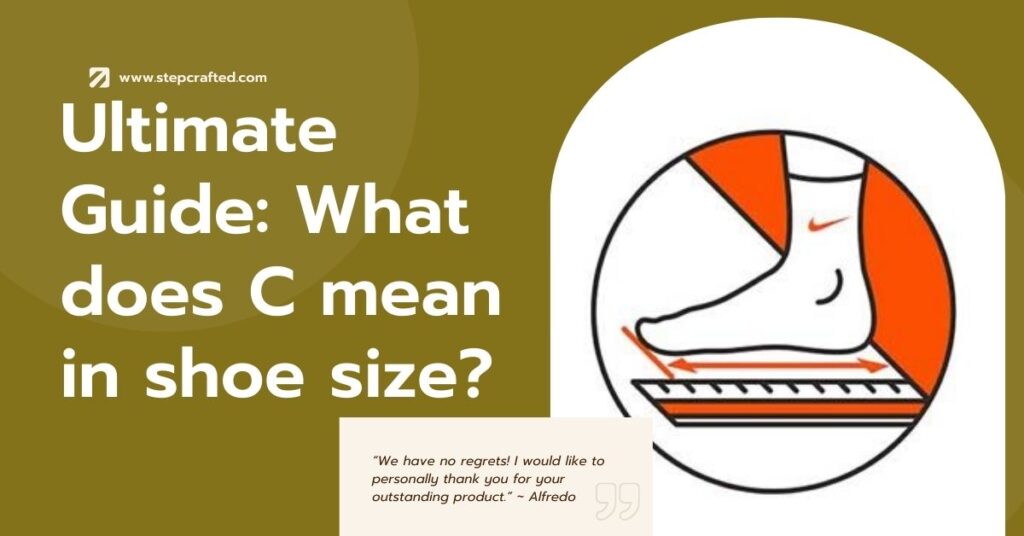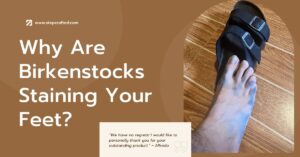Diving into the world of shoe shopping, we often stumble upon mysterious labels that leave us scratching our heads. You’ve probably heard of shoe sizes in numbers, but what’s with all the letters? Does this mean there’s a secret code to crack? Absolutely, and it’s not as elusive as it seems. Let’s demystify what does c mean in shoe size.
Contents
ToggleC represents the width of a shoe. Unlike length, which is denoted by numbers, the width is given a letter. This little letter on the shoe box can make a huge difference in how your shoes fit. Most of us waltz into a shoe store, eyeing that perfect pair, rarely paying attention to anything but how the shoes look. However, the C width is designed for those with moderately wide feet.
It’s a dimension that balances between too tight and too loose, a width wonder, if you will. This small detail can be the difference between a jaunty walk in the park and a hobble of discomfort.
So, the next time you find yourself shopping for that perfect fit, don’t overlook the letter C. It’s your guide to comfort and style, ensuring that your next walk will be as comfortable as it is stylish. Remember, the right fit is not just about the length but also the width. Decode the labels, and you’ll discover a whole new world of comfort and fit, one shoe at a time.
Understanding C in Shoe Size
When delving into the world of shoe sizes, the letter “C” can be a source of confusion for many. It’s a letter that carries different meanings, depending on the context and the brand you’re dealing with. In the realm of children’s footwear, “C” typically represents a “child” size, designated for children between the ages of 2 and 4. However, it’s essential to remember that the actual size can vary significantly from one brand to another. For example, a child size 2 could be roughly equivalent to a women’s size 4 or 5, highlighting the importance of understanding these distinctions to ensure a proper fit.
Child Size Connotation
Beyond its connotation with child sizes, the letter “C” in shoe sizing can also indicate the width of a shoe. For men, a “C” width usually signifies a narrow shoe, while for women, it points to a wider option. This distinction is crucial when shopping for footwear, as the proper width can significantly impact the comfort and support your shoes provide.
Whether you’re selecting a shoe for style or function, considering both the length and width measurements is key. Various systems are used to measure these dimensions, and gaining an understanding of them can help you make more informed choices.
In conclusion, deciphering the “C” in shoe size requires a dual understanding: recognizing its role in child size connotation and width designation. Whether you’re engaging in a bit of online shopping or visiting a physical store, being shoe-savvy means knowing how to navigate these varied interpretations.
Armed with this knowledge, you’re better equipped to find shoes that are not just a good fit in length but also perfect in width, ensuring your or your child’s feet are as happy and comfortable as can be, no matter where the day takes you.
For the ladies
For the ladies, a C width is akin to taking that liberating deep breath after a long day. It offers more room than the Bs and Ms, ensuring your feet aren’t crying out for mercy at the end of the day. But it’s not as expansive as a D or E, keeping things snug without crossing into squeeze territory. This balance makes the C size a favored option for those seeking comfort without sacrificing the fit.
As for the gents
As for the gents, size C pulls a chameleon act. It translates to a narrower fit, striking a balance for those who find the standard D a tad roomy. It’s the perfect middle ground between the tight embrace of a B and the freer space of a D, catering to men who desire precision in fit without veering too snug or too loose. This width serves as a versatile option, adapting to various foot shapes and sizes with ease.
Understanding what “C” means in shoe size can significantly impact your shoe shopping experience, whether you’re a lady looking for that just-right fit that won’t leave you desperate to kick off your shoes at the end of the day, or a gent in search of shoes that provide both comfort and style without the extra room of larger sizes.
Why is shoe width important?
When we talk about shoe size, the letter C often puzzles many. It’s not just a random letter but a significant indicator of shoe width. To put it simply, C denotes a specific width – not too broad, not too narrow, but perfectly moderate for those with a slightly wider foot. Understanding what C means in the context of shoe sizes can greatly impact your comfort and style.
Shoe width is as important as shoe size itself. Imagine trying to squeeze your foot into jeans two sizes too small; that’s what wearing the wrong shoe width feels like. It’s not just about avoiding the cramp; it’s about ensuring your feet have the right space to breathe and move without restriction. Width is pivotal to finding shoes that don’t just fit but feel as if they were made for your feet.
Toe overhang:
One of the sneaky issues arising from neglecting width is toe overhang. This happens when your foot width exceeds the shoe base, leaving your toes uncomfortably hanging over the edge. It’s not only uncomfortable but can also lead to restrictive movement and wanting to free your feet at the first chance you get.
Side pressures:
Similarly, side pressures can occur when shoes are too narrow, causing the sides of your feet to feel hugged a bit too tight. This width issue can lead to discomfort, making you eager to discard your shoes the moment you step inside your home.
Arch discomfort:
Lastly, arch discomfort is a common result of a misfit in width. Adequate support for your arch is essential, and wearing the wrong width can mess with this support. It’s crucial to find shoes that provide the right width to elevate your shoe game and dramatically improve the level of comfort you experience.
In conclusion, while C in shoe size is a measure of width, it’s a reminder of how important it is to find shoes that fit not just in length but in width too. Neglecting this aspect can lead to various discomforts, from toe overhang to arch discomfort. Let’s keep this in mind and ensure we choose shoes that offer both style and comfort, proving that the right width can truly transform your footwear experience.

What are the different types of shoe widths?
In the footwear world, understanding shoe widths is akin to deciphering a secret code. These widths, represented by alphabets, form a niche language that only the shoe-savvy might immediately grasp. Yet, it’s a game of logic and precision that can significantly impact the happiness of your feet. Let’s break down this cryptic system into crystal clear categories, making smart choices in shoe shopping an accessible feat for all.
Narrow widths:
- AAA, AA, and A: Represent the sleek and slender options in the shoe widths spectrum.
- Known as the runway model of widths, these sizes are ideal for those seeking a narrow fit.
- These widths cater to feet that require minimal room, ensuring a snug and elegant fit.
Medium widths:
- B and M for women, D and M for men: The every-person width, striking a balance between too narrow and too wide.
- These sizes serve as a safe bet for most people, offering a comfortable fit without the need for extra room or restrictive tightness.
- Medium widths are the go-to choice for those who desire comfort and fit without venturing into specialty sizes.
Wide Widths:
- C, D, E for women and E, EE, EEE for men: Designed for those who need expansive territory for their feet.
- These widths provide extra room to breathe, catering to feet that may stumble upon width codes and find conventional sizes restrictive.
- Opting for Wide Widths ensures comfort, eliminating the discomfort of narrow options and offering a liberating fit for happy feet.
In essence, shoe widths span a diverse range, from the narrow confines of AAA to the expansive embrace of EEE. This variety reflects the different needs of shoe buyers, providing options that go beyond the cryptic to become clear and understandable. Knowing these types enables smart shopping decisions, ensuring that every pair of shoes brings joy and comfort to your feet.
Whether you’re in the market for the elegance of narrow widths, the balance of medium widths, or the freedom of wide widths, this guide serves as your roadmap in the shoe-savvy language of fit and comfort.
How do you find your shoe width?
In the quest to find the perfect shoe, understanding width is just as important as numerical size. The letter C stands as a beacon for those navigating the shoe-savvy world, marking a specific width that could be the difference between comfort and discomfort.
But how do you correctly identify this crucial measurement? It’s a mix of DIY measuring, professional fittings, and navigating the brand shuffle each method providing its unique insights into achieving that perfect fit.
DIY measuring
DIY measuring is a simple yet effective tool at your disposal. Don’t underestimate the power of a ruler and a piece of paper. Lay your foot down, give it a quick trace, and then measure the width at its widest point. This approach is easy-peasy and super handy for those spontaneous online shopping sprees. It gives you a ballpark figure of your foot’s width, essential for making smart choices in the vast online world.
Professional fittings
For those seeking accuracy, professional fittings with a trusty Brannock device offer a magical, old-school method that’s hard to beat. A shoe professional will measure your foot perfectly from heel to toe and side to side, ensuring a fit that’s tailored to your unique shape. Investing in a quality pair of shoes? Professional fittings ensure they fit perfectly, enhancing both comfort and durability.
The brand shuffle
Navigating shoe widths can get tricky with the brand shuffle. Different brands, especially those from other regions, might interpret sizes in their unique way. Ever excitedly unboxed shoes from a European brand only to find they weren’t quite right? Each brand dances to its own tune when it comes to sizing, making it important to peek at their size charts before clicking buy.
Identifying your shoe width might initially feel like a chore, but it’s a game-changer. Effort and a sprinkle of patience can transform good into great. After all, why settle for comfort when you can achieve perfection? Your feet are the foundation of your daily journeys; they deserve all the comfort in the world.
By mastering these methods, you ensure your feet are as happy and supported as possible, no matter where they take you.
Comparing ‘C’ Sizes with Other Sizes
When embarking on the journey to find the perfect shoe, understanding what “C” means in shoe size can be a game-changer, especially for those with slim or slender feet. The “C” size represents a narrower width compared to the average shoe size, making it suitable for individuals seeking a snug fit without squeezing into uncomfortably tight shoes.
The world of shoe sizing can seem like a maze of letters, numbers, and specific codes, with each brand having its own way of labeling widths. In general, “A” represents the narrowest width, while “B” is considered a medium width.
For men, “D” is usually the standard medium width, whereas for women, “B” serves as the average. As you move beyond “D”, the sizes become progressively wider, catering to a diverse range of foot shapes and sizes.
In certain contexts, “C” might also represent a children’s shoe size or a medium shoe width, demonstrating the versatility and complexity of shoe sizing. For instance, children’s shoe sizes generally cater to ages between 2 and 4, with a child size 2 being approximately equivalent to a women’s size 4 or 5. Meanwhile, the “C” size in women’s shoes typically ranges from US 4-6, though this can vary depending on the brand and style.
Navigating these variations is crucial for achieving a comfortable fit. Different shoe brands may label widths in varying ways, making it important to try on shoes and consult size charts specific to each brand.
Dimensions and interpretations of sizes may vary significantly, highlighting the importance of understanding the differences between “C” sizes and other shoe size categories.
Ensuring an accurate sizing and perfect fit is essential, not only for comfort but also for providing support, stability, and preventing long-term foot issues caused by wearing ill-fitting footwear. With a little effort and patience, navigating the complexities of shoe widths and sizes becomes less of a chore and more of an informed journey toward finding shoes that fit perfectly, enhancing every step with overall comfort and style.
How is ‘C’ in Shoe Sizes Measured?
In the complex world of shoe sizes, the letter “C” often leaves shoppers puzzled. Does it represent a size, a width, or something else entirely? The answer is that “C” can carry different meanings, depending on the context in which it is used. Primarily, it can indicate a children’s shoe size or a medium width in adult sizes, making it crucial to understand these distinctions to find the right fit.

When “C” is used to denote a children’s shoe size, it stands for “child,” typically used for children aged 2-4 years old. The actual size can vary depending on the brand, but as a general rule, a child size 2 is approximately equivalent to a women’s size 4 or 5. It’s important to note that this sizing system is mostly used in the US.
On the other hand, in adult shoe sizing, “C” can indicate a medium width. Widths are usually denoted by letters ranging from “A” to “E,” where “A” is the narrowest and “E” is the widest. A “C width” means it falls in the middle of this range. However, the definition of medium width can vary across brands and sizing systems, so it’s essential to consult the specific brand’s sizing chart when determining the appropriate width.
To accurately measure the “C” in shoe sizes, whether for length or width, one must accurately measure the person’s foot. These measurements can then be compared to the shoe size chart provided by the brand to determine the correct shoe size. Additionally, it’s recommended to try on shoes in-store or order multiple sizes online to ensure the best possible fit. This approach is particularly important for children’s shoes, as their feet grow and develop at a rapid pace.
Navigating shoe sizes and widths can be challenging, but understanding the nuances of “C” in shoe sizing is a key step toward finding footwear that offers both comfort and style. Whether shopping for children or adults, being informed can help avoid the common pitfalls of ill-fitting footwear, ensuring every step is taken in comfort and confidence.
Tips for buying size C shoes
- Navigating the shoe store for that perfect pair can be quite the journey, especially when you’re on the path to finding size C shoes. It’s an interesting turn in your shoe-shopping guide, offering a unique fit for those who need it.
- Understand your need: It’s crucial to Familiarize yourself with the dimensions of size C to ensure a snug yet comfortable fit. This size is designed to provide comfort without the squeeze, making it perfect for both leisure and activity.
- Feel the materials: The Women’s Madrid Eco-Knit, for instance, highlights how recycled plastic bottles can be fashioned into shoes that offer stretchiness and breathability, affecting the overall fit and feel.
- Match the occasion: Always consider the setting when choosing your shoes. Whether it’s for a night out, an office day, or a brisk walk in the park, shoes tailored for specific activities can greatly enhance both comfort and longevity.
- Dive into technology: Embrace modern shoe technology like the Rabbit Foam™ outsole of the Lima, a wide shoe that pushes tech to a new level, blending design and functionality seamlessly.
- Break them in gradually: New shoes need some breaking in. Start with shorter intervals of wear to allow your feet and the shoes to adjust comfortably to each other.
- Easy entry: For those who value simplicity and effortless wearing, some shoes, like the Men’s Athens, offer hands-free design, making sliding in a breeze.
- Invest in quality socks: The right pair of socks can significantly complement a shoe’s fit. Choose socks that match the shoe’s purpose, whether thin for formal shoes or cushioned for athletic ones.
- Keep an open mind: Size C isn’t restricted by gender. Many standout shoes, like the Men’s Roamer and the Women’s Vegas, come in both men’s and women’s versions.
- Mix and match: While width is crucial, don’t forget to consider other shoe features. The Women’s Prague, for example, offers a beautiful marriage of canvas and suede, plus removable insoles for customization.
- Maintenance is key: Regular cleaning and the use of protective sprays or creams can extend the life of your size C shoes and ensure they stay comfortable for a long time.
By following these tips, you’re not just purchasing footwear; you’re investing in your comfort, style, and foot health, ensuring that each step you take is supported, stylish, and secure.
Key Factors to Keep in Mind When Selecting ‘C’ Sized Footwear
Measure the child’s foot:
When selecting ‘C’ sized shoes, it’s crucial to start with accurately measuring the child’s foot. As feet can grow rapidly, especially in children aged 2-4 years, taking both length and width into account is essential to ensure the best fit. This initial step represents the foundation of finding comfortable and supportive footwear for young walkers.
Use a brand-specific size chart:
Given that size ‘C’ may vary among brands, it’s essential to use a size chart specific to the brand or manufacture you’re considering. Comparing your child’s foot measurements to the brand’s chart can significantly help in finding the perfect pair of shoes. This brand-specific approach accounts for variations in sizing standards and ensures a more tailored fit.
Check for flexibility and support:
Children’s shoes should offer the right balance between flexibility and support. This balance is crucial to accommodate their development and movement needs. Shoes that are too rigid can hinder natural foot movement, while overly flexible shoes may not provide sufficient support for their growing feet.
Consider growth:
Since children’s feet grow quickly, choosing shoes with some room for growth—while still maintaining a secure fit—is wise. This consideration helps avoid frequent replacements and supports healthy foot development without compromising on comfort or safety.
Prioritize comfort:
Finally, ensuring that the shoes are comfortable for the child is paramount. Checking for proper cushioning and breathability can prevent discomfort and foot health issues down the line. Comfortable shoes encourage more active play and can have a positive impact on a child’s overall well-being.
By remembering these crucial considerations when choosing ‘C’ sized shoes, you can help find the right fit for your child’s rapidly growing feet, prioritizing their comfort, development, and style. It’s not just about the size; it’s about ensuring every step they take is supported and free from discomfort.
Width Sizing: Debunking Myths and Addressing Concerns
The shoe widths and their meanings often plunge shoppers into a realm of myths and misconceptions. Understanding what “C” means in shoe size can illuminate the path to a perfect fit, dispelling the fog of commonly held beliefs that often misguide.
Feet forever static
A widely accepted myth is that our feet remain forever static once we hit adulthood. Contrary to this belief, life events such as aging, weight fluctuations, and pregnancy can cause subtle changes in both size and width. These dimensions are not as unchangeable as a manicure, emphasizing the need for periodic measurements to ensure comfort.
The size-up solution
Another notion is the size-up solution. If a shoe feels too narrow, simply going a size up in length seems like a quick fix. However, this practice often leads to heel slippage, an awkward shuffle, and a sense of being lost in a shoe that’s too long. It’s a misguided approach that ignores the nuances of finding a properly fitting shoe.
Visible width needs
The visible width needs of our feet are not always as they appear. “Don’t judge a book by its cover” applies aptly to shoe shopping. A slender silhouette does not necessarily mean a narrow fit will suffice, nor does a spacious toe box guarantee comfort. Comfort is about how it feels, not how it looks, underscoring the importance of choosing shoes based on more than just appearance.
In conclusion, when navigating the shoe widths in search of that perfect pair, combining style with practical knowledge is key. Being aware of how to determine the right size and width for your feet can debunk these myths and lead to a more informed, comfortable, and satisfying shoe-shopping experience.
Bottom Line
At the bottom line of understanding what “C” means in shoe size, we believe that knowledge is the foundation of a great shoe experience. The number on the shoe box tells only a part of your foot’s story; the width dimension, whether it’s size C or another, is equally important. This piece of information is not just a trivial detail; it’s central to finding footwear that feels as if it was made just for you.
Armed with insights about width, you’re now equipped to make informed decisions that prioritize comfort, fit, and style. Because ultimately, when your feet are happy, it shows in every step you take. It’s about more than just the aesthetics of the shoe; it’s about how it complements and supports the unique contours of your feet, ensuring that every journey, no matter how long or short, is a testament to the perfect harmony between comfort and style.
FAQ
What size is a 7 C?
| Region | Size | Age (Months) | Foot Length (in) |
|---|---|---|---|
| US – Kids | 1C | 3 | 3 9/16 |
| US – Kids | 7C | 36 | 5 9/16 |
| UK | 0.5 | 3 | 3 9/16 |
| UK | 6.5 | 36 | 5 9/16 |
| EU | 16 | 3 | 3 9/16 |
| EU | 23.5 | 36 | 5 9/16 |
What size is 7C?
A 7C shoe size is designed for toddlers aged between 2 to 2.5 years, with their feet measuring 5⅜ inches (12.7 cm) long. This size categorizes shoes that fit the specific foot dimensions of young children in this age group, ensuring a comfortable and proper fit for their daily activities and growth needs.
What is C and J in shoe size?
In children’s shoe sizes, C and J stand for Child and Junior categories, respectively. These labels are used as shorthand to split the sizing into two distinct categories. For instance, “C7” means Child Size 7, indicating it’s designed for younger children, while “J4” translates to Junior Size 4, which also equates to a men’s size 4. This classification helps in selecting the appropriate shoe size for children at different stages of growth, ensuring a better fit and comfort.
What is C and J in shoe size?
In the world of shoe sizing, size 7 varies between genders and geographical regions. For women’s shoes, a US size 7 is typically equivalent to a European size 37 or 38, illustrating slight variations across different brands and styles. Conversely, for men’s shoes, a US size 7 is generally equivalent to a European size 40 or 41. This disparity highlights the importance of understanding what “C” means in shoe size and the necessity to consult size charts specific to each brand and region to ensure an accurate fit.
What is C in sneakers?
In the sizing world of sneakers, “C” stands for children, marking sizes specifically designed for the little ones. The “Y” denotes youth, catering to older kids. Sizes range from the smallest at 9c to 1y, next up from 13c to 4y, and the biggest scale running from 3y to 9, bridging the gap between toddler years and adolescence. This system ensures that as children grow, their footwear can grow with them, providing the perfect fit and comfort whether they’re just taking their first steps or sprinting into their teen years.





